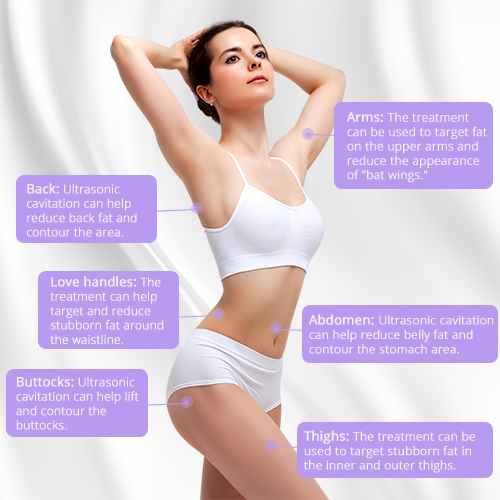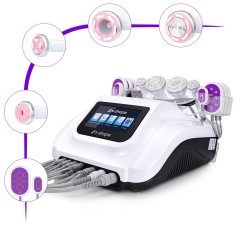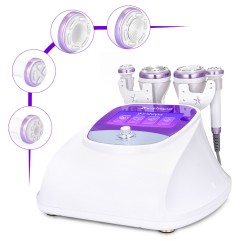 From a clinical perspective, ultrasounds are most effective for non-invasive fat reduction. Using depression and compression cycles of frequency, they can aid in releasing triglycerides and fat cell rupture.
From a clinical perspective, ultrasounds are most effective for non-invasive fat reduction. Using depression and compression cycles of frequency, they can aid in releasing triglycerides and fat cell rupture.
Surgeons and patients worldwide are satisfied with liposuction for body shaping, yet non-invasive, comfortable, and safe methods are still in demand with minimal downtime. Various treatments like radiofrequency, electric stimulation, low-level lasers, and mechanical massage are capable of localized fat reduction. But considering safety, they’ve not met the expectations and raised concerns.
Ultrasonic cavitation machine is an instrument approved FDA by for cosmetic treatment in 2011. They focus on ultrasound for the localized mechanical motion of cells and tissues. Only non-invasive devices that disrupt cellular membranes or cause tissue coagulation using sound waves are approved. This technology is now very mature and continues to innovate.
Let’s evaluate the mechanism and ultrasonic cavitation machines in detail. We will delve into their effectiveness and address the relevant concerns. From understanding the machine parameters to the biological mechanism of adipocyte destruction and clinical efficacy evaluation, we’ll cover it all. By understanding the research progress, benefits, and associated risks, you can make informed decisions about usage and seek beauty enhancements. Let’s get started.
Is there scientific evidence to support the effect of ultrasonic cavitation machines on weight loss?
Clinical trials are essential for testing the efficacy of ultrasonic cavitation machines. Several studies are there using specific protocols, and researchers have developed protocols and parameters for different body parts. Also, patient observations are documented to check for reactions and side effects. They include pre- and post-treatment analysis, noting any complications and skin changes like redness or mild bruising.
In this sense, Gold et al evaluated the effects of a 16-week ultrasound application on flank reduction in men and women. The outcomes demonstrated that all participants significantly reduced fat in the treated area as measured by ultrasound and caliper.
Also, standardized guidelines are developed for a responsible and accountable approach.
Some of them include:
- a. Using enough special ultrasonic gel and avoiding overheating the heads
- b. Using different probes for specific body parts and handling their heads with care
- c. Avoiding bone area during treatment and don’t spend too much time on a single area
- d. Using dry cotton towels for cleaning instead of disinfectants
- e. Both patients and operators should not have any metallic items or jewelry
- f. After treating one target area, there should be rest before proceeding to the next
- g. The contact between the probe and skin should be close, and the operator should adjust the intensity depending on the body area
- h. Massage in the right direction is essential during treatment.
- j. The special gel should always be used. No essential oil can serve as an alternative
What progress has been made in the research of ultrasonic cavitation machines in clinical applications?
Ultrasound cavitation machines are known for their clinical applications, such as body contouring, fat reduction from certain body parts, and skin tightening using a specific range of frequencies. Several types of research have been done to prove their effectiveness. Using different methodologies, researchers explored what can make these treatments more effective. A study published in 2021 examined “The Effect Of Focused Ultrasound Cavitation Combined With Aerobic Exercise On Abdominal And Intra-Hepatic Fat In Patients With Non-Alcoholic Fatty Liver Disease (NAFD)."
As obesity is also linked to liver metabolic diseases, trials were made to analyze whether cavitation machines will work on these patients to remove their abdominal fat. This research conducted the test on 34 patients having fatty liver disease, aged between 30-45, with a BMI of 30–40 kg/m2. A comparative analysis for Abdominal subcutaneous fat volume, BMI, liver-to-spleen ratio (L/S ratio), visceral fat volume, body weight, and waist circumference was done by dividing the patients into two groups.
Group A was treated using Focused Ultrasound Cavitation and light aerobic exercise, while Group B was given only moderate aerobic exercise. Both groups showed improvements in subcutaneous fat volume, visceral fat volume, body weight, BMI, and waist circumference compared to initial measurements.
Still, the percentage of improvement was higher in the group. This study showed that an ultrasound Cavitation Machine combined with moderate exercise could remove abdominal and intra-hepatic fat in patients with non-alcoholic fatty liver disease (NAFD).
Scientific research field of the ultrasonic cavitation machine
Here are some details of recent advancements and the future potential of ultrasound cavitation machines.
1. Optimization of Ultrasound Parameters for Effective and Safe Treatment
As ultrasound cavitation machines are becoming more popular in the beauty industry for fat reduction and body contouring, making their treatment safer and more effective becomes crucial. To increase effectiveness and safety, one must know some parameters that should be optimized due to their importance. These parameters may include
- a. Ultrasound Frequency
- b. Efficacy and Safety
- c. Duration time and treatment area
A. Ultrasound Frequency
Ultrasound frequency, measured in hertz (Hz), is the number of sound waves emitted per second. Frequency is the key factor that impacts the treatment outcomes because the penetration of ultrasound waves depends on its frequency. As far as the frequencies are concerned, they are of low frequency and high frequency, and the effect of each frequency range may vary because different frequencies have different penetration depths and interactions with the body tissues.
Low Frequency (20-60 kHz)
Low frequencies have deeper penetrations due to their longer wavelengths and can reach subcutaneous fat layers. Also, they are less focused, can be used for larger areas such as the abdomen, thighs, and buttocks, and are best used for treating deep tissue layers. For example, adipose tissue is a connecting tissue that regulates the energy supply throughout the body. If it is increased, it can lead to obesity because it is a fat tissue between the skin and muscles, and it also surrounds the organs in the abdominal cavity; its cavitation is best at lower frequency ranges, i.e., 20-30kHz.
High-Frequency (1-3 MHz)
Mostly kilohertz(kHz) frequencies are preferred in cavitation, but it doesn't mean higher frequencies (MHz) are not used. High-frequency ultrasound cavitation provides shallow penetration, suitable for treating areas like the face, neck, and arms, making it ideal for targeting superficial fat layers. Its focused nature helps to target specific areas resulting in localized fat reduction and enhanced body contouring effects. Some things to consider while optimizing frequency include the following:
- Body Composition: Every individual has varying fat thickness and tissue densities across their body, so it is required to adjust the frequency according to their body composition to get the targeted fat reduction and better treatment outcomes.
- Treatment Response: Regularly check the individual's response to the selected frequency. It will help to determine if the chosen frequency is giving the desired results and helps to balance the frequency selection.
B. Intensity And Duration of Action
Intensity and duration of action in ultrasound cavitation machine treatments are crucial for achieving efficacy and safety. Intensity determines the strength of ultrasound waves emitted from the cavitation machine during treatment. The increased Intensity of an ultrasound cavitation machine directly influences the effectiveness of fat cell disruption and elimination. It enhances the efficacy of the cavitation machine resulting in more significant fat reduction and body contouring effects.
It is essential to consider the duration of action or treatment time to balance safety and efficacy because higher intensity can yield better results. It refers to the length of time the ultrasound waves are applied during each treatment session and how often you have cavitation treatment. After exposure to these waves, the patient's body needs some time to recover. Also, monitoring and controlling the intensity level is crucial to avoid adverse effects such as discomfort, skin burns, or damage to surrounding tissues.
C. Considering Treatment Area for Targeted Results
When using ultrasound cavitation machines, consider the treatment areas for optimal results because fats are distributed in different body areas with varying compositions, depths, and densities. For example, superficial fat may include specific areas like the face, neck, and arms having thinner fat layers closer to the skin surface. Treating these areas requires a customized approach to address the specific fat distribution, and subcutaneous fats include areas like the abdomen, thighs, and buttocks, having deeper subcutaneous fat layers. So it is essential to customize the treatment parameters to penetrate and target these deeper fat deposits appropriately for the best results. You can consider these tips for this purpose. This article has a more comprehensive description of the ultrasonic cavitation treatment area.
- Ⅰ. Adjusting Intensity: Higher intensity can suit areas with thicker fat layers, while lower intensity is preferred for more delicate areas, ensuring better results.
- Ⅱ. Adjusting Frequency: Altering the ultrasound frequency according to the treatment area can optimize penetration depth, enabling effective fat cell disruption. Higher frequencies work best for superficial areas, while lower frequencies are a good option for deep fat layers.
- Ⅲ. Utilizing Different Applicators: Ultrasound cavitation machines often offer various applicators or hand pieces specifically designed for different body parts, and if you consider the size, shape, and contour of the treatment area when selecting the applicator, it will ensure precise targeting and optimal results in specific treatment areas.
- Ⅳ. Use Strategic Approach: Design treatment plans that address multiple body areas systematically and strategically and allow for consistent and harmonious body contouring to achieve overall balance and proportionality.

2. Investigating the Biological Mechanisms of Adipocyte Destruction and Metabolism
Let’s investigate the adipocyte fat cell destruction mechanisms using ultrasonic cavitation machines, comparing them with other methods and exploring the benefits and downsides of machines.
For dietary fatty acids, subcutaneous adipose tissue act as a buffer. They are stored and released depending on several factors, like diet. The concentration of consumed polyunsaturated fatty acids is essential, and ultrasonic cavitation can be used to reduce the chance of metabolic disorders. It causes lysis of adipose tissue due to damage to the cell membrane. From damaged cells, triglycerides are released, and the lymphatic system drains them out.
Ultrasonic cavitation is a non-invasive method that uses high-intensity and varied frequency sound waves. The waves lead to microbubbles (gas or vapor) formation with considerable pressure from the ultrasonic field. Also, subcutaneous tissue will respond to frequency leading to the implosion of the bubbles. The cell membrane of adipocytes will be ruptured, leading to fat extravasation. The elimination involves natural physiological pathways. The triglycerides will first move to interstitial fluid, and then the venous or lymphatic system will take them over. Then, it will be moved to the liver to metabolize again and be removed from the body.
3. Development of cavitation technology
Over the years, manufacturers have aimed to enhance the therapeutic effects by making technological improvements and amendments. Also, the clinical applications are extended and diversified, including innovations in ultrasonic probe design, controlling treatment parameters, image navigation, and enhancement
A. Innovations In The Design Of Ultrasonic Probes
The handy design of the probe allows for increasing the effectiveness and efficacy of treatment. For example, machines have different handle types:
- a. A fat head probe for fierce impact: It’ll cause fat cells to explode instantly and be used to treat a significant area at once.
- b. A bipolar probe with outspreading nature: The roller will massage over the body leading to decomposing effect.
- c. Tripolar facial probe for the face: It is specifically directed for facial areas to restore elasticity and enhance rejuvenation.
- d. Fast and active sextupole probe using controlled depth technology: The incisive positioning aids in reaching the deep-seated fat layer and improving tissues.
- e. Quadrupole coupling electrode for subcutaneous tissues: It’ll give the effect of fat decomposing.
Along with different shapes, manufacturers have also optimized the probe size. Example: Smaller probes target the specific areas precisely for the face and neck. Larger probes are for bigger areas like legs, arms, and thighs. The designs are ergonomic to ensure improved maneuverability and comfortable handling during treatment. The probe design also involves power, energy distribution, and varying frequency. Higher frequencies are meant for superficial fat layers, while lower ones help penetrate tissues. Now, probes have a feature to switch frequencies helping practitioners to tailor their treatment to patient needs.
B. Control of Treatment Parameters
Developing sophisticated control systems in ultra-cavitation machines also helps manage treatment parameters. The system offers control over parameters like:
- a. Adjusting cavitation frequency in a range like 40KHz-28KHz
- b. Cavitation output range like 100W maximum
- c. Targeting subcutaneous adipose tissue of specific thickness like ≥ 2.5 cm in the targeted area
- d. Varying energy levels like 85.3 to 270 J/cm2
- e. Varied duration, e.g., 60 to 90 minutes
- f. A varied power supply like 110/220V+10% 60HZ 6A
- g. Multiple output modes and probe designs like flat, monopolar, or bipolar
The controls offer treatment customization based on patient characteristics. It can be target area, body type, and desired outcomes. Recent cavitation machines also have algorithms to optimize parameters in real time. They can also utilize feedback mechanisms to ensure safety during the cavitation process. For example, there can be tissue response monitoring and power level adjustment. Also, the machines can automatically adapt parameters to minimize adverse impacts.
Final Thoughts
Ultrasonic cavitation machines offer a cost-effective and non-invasive solution for body contouring and fat reduction. They have minimal downtime, are safe for the body, and can target localized areas with fat deposits. While there may be limitations for obesity and high-fat situations, it’s a viable option for those who want to enhance their appearance.
You may like
-
-

Brand: ARISTORM
ARISTORM S Shape 6 in 1 Cavitation Machine Body Sculpting Facial Anti-Aging Skin Tightening
$899.00
-

Brand: ARISTORM
ARISTORM S Shape 30khz Cavitation Machine for At-Home Body Contouring Skin Tightening
$699.00


